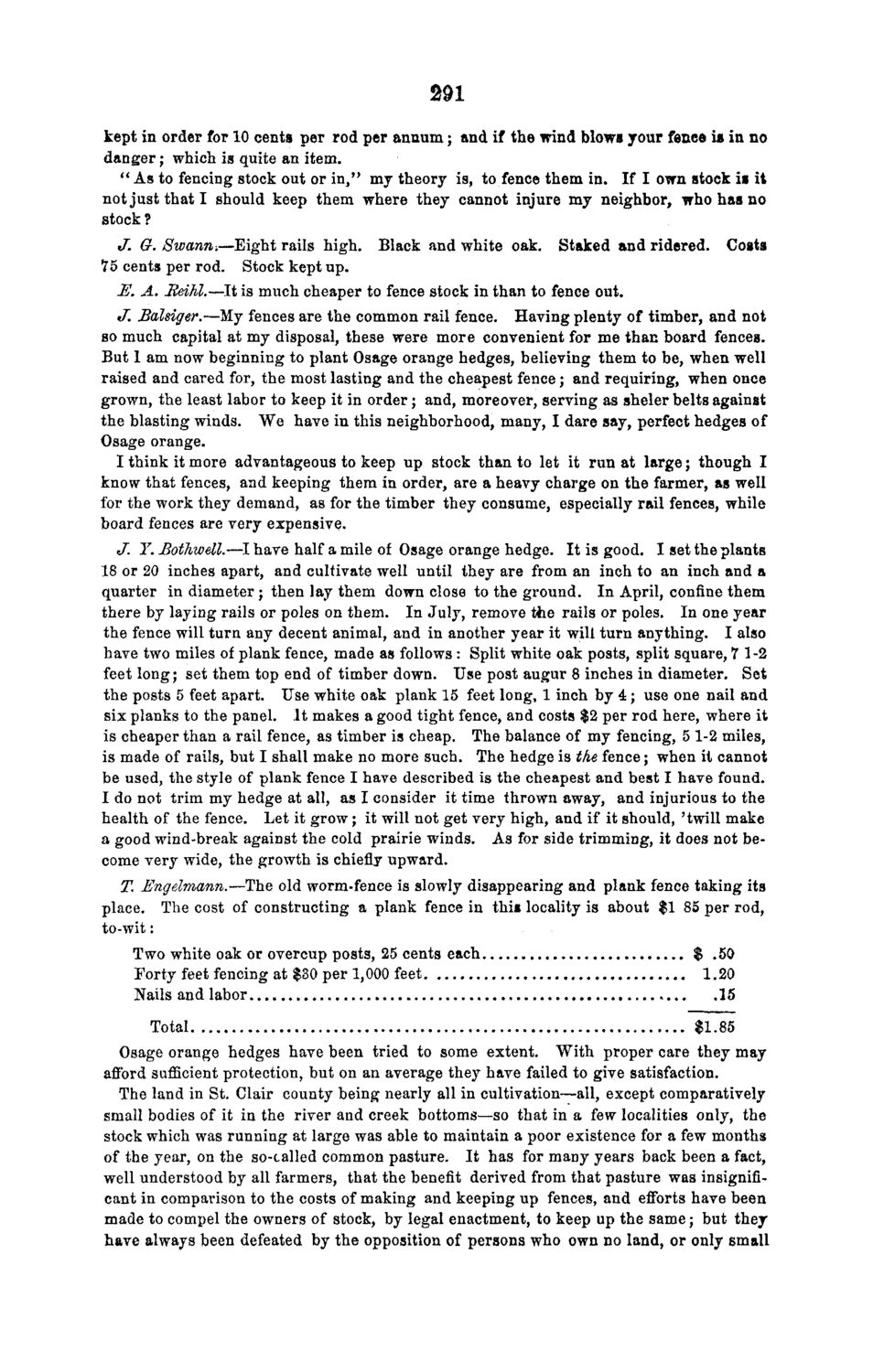| |
| |
Caption: Board of Trustees Minutes - 1868
This is a reduced-resolution page image for fast online browsing.

EXTRACTED TEXT FROM PAGE:
291 kept in order for 10 cents per rod per annum; and if the wind blows your fence is in no danger; which is quite an item. " As to fencing stock out or in," my theory is, to fence them in. If I own stock is it notjustthatl should keep them where they cannot injure my neighbor, who has no stock ? J. G. Swann.—Eight rails high. Black and white oak. Staked and ridered. Costs 75 cents per rod. Stock kept up. E. A. Reiki.—It is much cheaper to fence stock in than to fence out. J. Balsiger.—My fences are the common rail fence. Having plenty of timber, and not so much capital at my disposal, these were more convenient for me than board fences. But 1 am now beginning to plant Osage orange hedges, believing them to be, when well raised and cared for, the most lasting and the cheapest fence; and requiring, when once grown, the least labor to keep it in order; and, moreover, serving as sheler belts against the blasting winds. We have in this neighborhood, many, I dare say, perfect hedges of Osage orange. I think it more advantageous to keep up stock than to let it run at large; though I know that fences, and keeping them in order, are a heavy charge on the farmer, as well for the work they demand, as for the timber they consume, especially rail fences, while board fences are very expensive. J. T. Bothwell.—I have half a mile of Osage orange hedge. It is good. I set the plants 18 or 20 inches apart, and cultivate well until they are from an inch to an inch and a quarter in diameter; then lay them down close to the ground. In April, confine them there by laying rails or poles on them. In July, remove the rails or poles. In one year the fence will turn any decent animal, and in another year it will turn anything. I also have two miles of plank fence, made as follows : Split white oak posts, split square, 71-2 feet long; set them top end of timber down. Use post augur 8 inches in diameter. Set the posts 5 feet apart. Use white oak plank 15 feet long, 1 inch by 4; use one nail and six planks to the panel. It makes a good tight fence, and costs $2 per rod here, where it is cheaper than a rail fence, as timber is cheap. The balance of my fencing, 5 1-2 miles, is made of rails, but I shall make no more such. The hedge is the fence; when it cannot be used, the style of plank fence I have described is the cheapest and best I have found. I do not trim my hedge at all, as I consider it time thrown away, and injurious to the health of the fence. Let it grow; it will not get very high, and if it should, 'twill make a good wind-break against the cold prairie winds. As for side trimming, it does not become very wide, the growth is chiefly upward. T. Engelmann.—The old worm-fence is slowly disappearing and plank fence taking its place. The cost of constructing a plank fence in this locality is about $1 85 per rod, to-wit: Two white oak or overcup posts, 25 cents each $ .50 Forty feet fencing at $30 per 1,000 feet 1.20 Nails and labor .15 Total $1.85 Osage orange hedges have been tried to some extent. With proper care they may afford sufficient protection, but on an average they have failed to give satisfaction. The land in St. Clair county being nearly all in cultivation—all, except comparatively small bodies of it in the river and creek bottoms—so that in a few localities only, the stock which was running at large was able to maintain a poor existence for a few months of the year, on the so-called common pasture. It has for many years back been a fact, well understood by all farmers, that the benefit derived from that pasture was insignificant in comparison to the costs of making and keeping up fences, and efforts have been made to compel the owners of stock, by legal enactment, to keep up the same; but they have always been defeated by the opposition of persons who own no land, or only small
| |